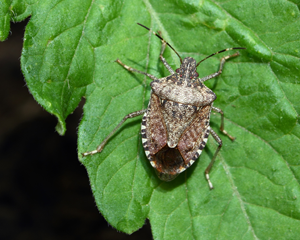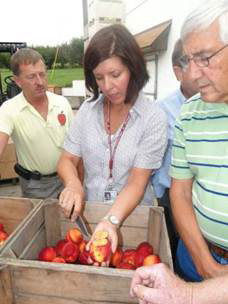A Stinker of a Pest: IPM Researchers, Educators Team Up against Brown Marmorated Stink Bug
 |
|
Stink bugs are aptly named. Some say this species smells like a combination of cilantro and burnt rubber. But not all stink bugs are pests and some are beneficial, preying on common garden pests. |
A new pest has been pigging out on many of North America’s most important crops, posing an unprecedented threat to U.S. farmers. The brown marmorated stink bug (BMSB) burst onto the scene in 2010, causing catastrophic damage in most mid-Atlantic states. Some growers of sweet corn, peppers, tomatoes, apples, and peaches reported total losses that year.
The U.S. Department of Agriculture has now awarded $5.7 million to ten institutions across the country for research and education to help growers cope.
The NEW New Bad Bug
The value of susceptible crops in the 33 states where BMSB has been established or sighted exceeds $21 billion, says Tracy Leskey, the USDA entomologist at the project’s helm. Last year, the pest cost apple growers alone $37 million.
Leskey’s team of 51 researchers has its work cut out: uncover the mysteries of BMSB and use that knowledge to find management tactics that work—traps and lures, biopesticides, and natural enemies that kill BMSB. The Northeastern IPM Center will coordinate outreach, putting solutions in the hands of growers who need them.
A Broad-Spectrum Pest
Collaborating to Battle BMSB
Scientists at the following institutions share the $5.7 million USDA Specialty Crop Research Initiative grant on the biology, ecology, and management of the brown marmorated stink bug:
- Agricultural Research Service Appalachian Fruit Research Station (Leskey)
- Univ. of Maryland (Hooks)
- Rutgers Univ. (Hamilton)
- Cornell Univ. (Koplinka-Loehr, Agnello)
- Virginia Tech (Bergh)
- Pennsylvania State Univ. (Krawczyk, Harper)
- Oregon State Univ. (Shearer)
- North Carolina State Univ. (Walgenbach)
- Univ. of Delaware (Whalen)
- Washington State Univ. (Brunner)
BMSB arrived from Asia circa 1996, touching down in Allentown, PA, and quickly becoming a nuisance pest by overwintering in homes, office buildings, and warehouses. By 2004 it was showing up on farms and in forests. BMSB has a huge host range, also hitting field crops, ornamentals, and woodland trees, feeding on about 300 species altogether.
“It’s the worst I’ve seen yet,” said University of Maryland entomologist Galen Dively, whose career spans 45 years. Growers will need sprays for the near term, so Dively and a group of researchers are testing a range of conventional and biological pesticides on tomato, pepper, and eggplant. “You can kill ninety percent of them, but the next day you might have just as many,” Dively said in June 2011 as he surveyed research plots in eastern Maryland. Since these pests move in waves from woods to fields and orchards, he guessed that this year they’d see an “order of magnitude” more than in 2010.
They might have—but then came July’s record heat and drought. Young BMSB molt five times before adulthood and are vulnerable to drying—and dying—right after they’ve shed their skins. “I think it scorched them,” Dively says. “Right now we aren’t seeing nearly what we expected.” Losses in 2011 weren’t as devastating—but wacky weather could be why.
A Balancing Act for Growers
Growers have sprayed aggressively to keep BMSB in check. But broad-spectrum sprays such as pyrethroids also kill beneficial insects that dine on pests, hampering nature’s own checks and balances. Beneficials help IPM growers protect crops through science-based tactics that keep environmental and economic costs as low as possible.
Henry Chiles of 1,500-acre Crown Orchard in Virginia saw severe damage in 2010. “We tried everything possible, including many sprays of pyrethroid insecticides, with no results,” he reported in a letter to USDA in 2010. “Now we’ve destroyed our IPM program that we have worked so hard for the past 10-plus years to establish and maintain.”
 |
|
Tracy Leskey (USDA Agricultural Research Service) examines BMSB injury to fruit at an emergency meeting held with growers in Maryland last September. |
The New Jersey Peach Promotion Council’s 2010 letter echoed these sentiments: though pyrethroids worked in some orchards, they also “lead to increased mite populations and other secondary pests, creating the need for more pesticides. This means that our IPM programs are at risk and pesticide use and associated costs will increase.”
In West Virginia, Clarissa Mathews, entomologist and environmental sciences professor at Shepherd College—and also co-owner of Redbud Organic Farm—is experimenting with movable cages for tomato and pepper crops on her farm. The cages are made of PVC pipes and screening—“sort of like mini hoop-houses,” she says. But they’re still unproven. And Mathews might not have much time. “Two bad years would put us under,” she says. “Every week we talk about whether we can keep Redbud going.”
New York is among northeastern frontier states where BMSB is on the move, and 2011 marked the first ag sighting. “Organic peppers were badly injured on a Hudson Valley farm,” says Peter Jentsch, a Cornell University researcher on the team. Indeed, organic growers have a hard row to hoe. No organically approved pesticides keep BMSB at bay. Traps and lures, beneficials, and biorationals could be several years from deployment.
Staying One Step Ahead
The spark for a broad-based BMSB management project came in early 2010 when Tracy Leskey put out the call to colleagues and assembled a working group funded by the Northeastern IPM Center. The group’s early discussions spurred members to pursue a coordinated solution, and within a few months plans for national research and outreach were underway. None too soon; this pest loves oranges and has hitchhiked to Florida and the West Coast.
The BMSB working group wants to stay one step ahead, and it met with the project team in late November 2011 to share the lessons from this year. “We have so much to learn,” says Leskey. “We’re looking at every angle to fight this thing.”
— by MARY WOODSEN
The Northeastern IPM Center promotes integrated pest management for reducing risks to human health and the environment. If republishing our news, please acknowledge the source (“From Northeast IPM Insights”) along with a link to our website.
